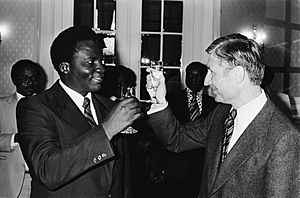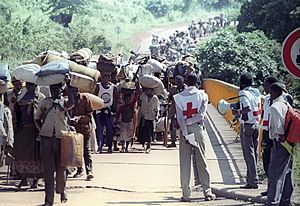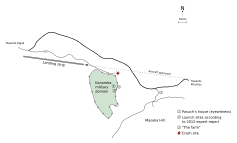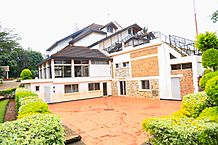Juvénal Habyarimana facts for kids
Quick facts for kids
Juvénal Habyarimana
|
|
|---|---|
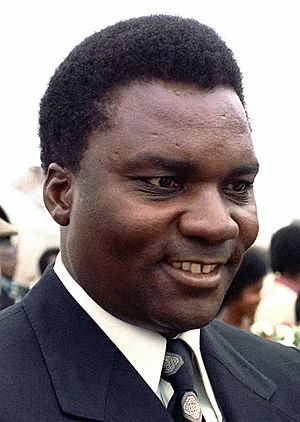
Habyarimana in 1980
|
|
| 2nd President of Rwanda | |
| In office 5 July 1973 – 6 April 1994 |
|
| Prime Minister | Sylvestre Nsanzimana Dismas Nsengiyaremye Agathe Uwilingiyimana |
| Preceded by | Grégoire Kayibanda |
| Succeeded by | Théodore Sindikubwabo (interim) |
| Personal details | |
| Born | 8 March 1937 Gisenyi, Ruanda-Urundi |
| Died | 6 April 1994 (aged 57) Kigali, Rwanda |
| Cause of death | (Assassination) surface-to-air missile |
| Nationality | Rwandan |
| Political party | MRND |
| Spouse |
Agathe Habyarimana
(m. 1963) |
| Alma mater | Lovanium University Kigali Military Academy |
| Military service | |
| Allegiance | |
| Years of service | 1963–1994 |
| Rank | Major-general |
| Unit | Rwanda National Guard |
| Battles/wars | Bugesera invasion Rwandan Civil War |
Juvénal Habyarimana (8 March 1937 – 6 April 1994) was a Rwandan politician and military officer. He served as the second President of Rwanda from 1973 until 1994. People sometimes called him Kinani, which means "invincible" in the Kinyarwanda language.
Habyarimana was from the Hutu ethnic group. He worked in several security roles, including minister of defense, under Rwanda's first president, Grégoire Kayibanda. In 1973, Habyarimana took power in a military coup. He then became the new president. He continued some of his predecessor's policies that favored Hutus.
During his time as president, Rwanda became a one-party state. This meant his political party, the MRND, was the only legal party. People were often required to attend large events and show support for the president. Even though the country became a bit less poor during his rule, most Rwandans still lived in extreme poverty.
In 1990, the Tutsi-led Rwandan Patriotic Front (RPF) started the Rwandan Civil War against his government. After three years of fighting, Habyarimana signed a peace agreement called the Arusha Accords in 1993. The next year, his airplane was shot down by a missile near Kigali, Rwanda. The president of Burundi, Cyprien Ntaryamira, was also on the plane and died. This event made ethnic tensions much worse and helped start the terrible 1994 genocide against the Tutsi.
Contents
Early Life and Education
Juvénal Habyarimana was born on March 8, 1937. His family was wealthy and lived in Gisenyi, which was then part of Ruanda-Urundi. He went to the College of Saint Paul in Bukavu, Belgian Congo, where he studied mathematics.
In 1958, he started medical school at Lovanium University in Léopoldville. But he left medical school the next year when the Rwandan Revolution began. He then joined the officer training school in Kigali. He finished his training with high honors in 1961. After that, he became an assistant to the Belgian commander in Rwanda. In 1962, he married Agathe Kanziga.
In 1963, Habyarimana became the head of the Garde Nationale Rwandaise. Two years later, he was made Minister of the National Guard and Police.
Becoming President of Rwanda
On July 5, 1973, Habyarimana was the Army Chief of Staff and minister of defense. He took control of the country in a military takeover. He removed the president, Grégoire Kayibanda, and his ruling party.
In 1975, Habyarimana created a new political party called the Mouvement Révolutionnaire National pour le Développement (MRND). This became the only legal party in the country. The government was mostly run by military leaders until 1978. That year, a new constitution was approved by a public vote. Habyarimana was then elected president for a five-year term. Since he was the head of the MRND, he was the only candidate. He was reelected in 1983 and 1988, also as the only candidate each time.
At first, Habyarimana, who was Hutu, seemed to treat both Hutu and Tutsi groups fairly. However, this did not last. His government began to favor Hutus, similar to the policies before him. For example, there were rules that made it harder for Tutsis to get jobs in universities and government. As Habyarimana focused on a smaller group of supporters, some Hutus who felt left out started working with Tutsis. This was to try and weaken his leadership. By the time the Rwandan Patriotic Front (RPF) invaded, Habyarimana's closest supporters were mainly a small group of Hutu extremists from his home region. This group was known as the akazu, meaning "little house".
From 1975 to 1990, the MRND party and Habyarimana's government were very closely linked. Local leaders represented both the government and the party. Laws and party rules were passed down from the president to local areas. One important policy was Umuganda. This required Rwandans to spend half a day each week working on community projects like building roads.
In 1990, there was growing pressure from other countries, like France, and organizations like the IMF and the World Bank. Many Rwandan citizens also wanted more say in their government and economic changes. Because of this, Habyarimana agreed to allow other political parties to form.
The Rwandan Civil War
In October 1990, a group of rebels called the RPF attacked Habyarimana's government. The RPF was made up mostly of Tutsi Rwandan refugees and people who had lived outside Rwanda. Many of them had served in the Ugandan army. The attack began when they crossed the border from Uganda.
Habyarimana was in New York City for a United Nations meeting when the attack started. When he heard the news, he asked France for help. The French government sent troops, saying they were there to protect French citizens. The president of Zaire, Mobutu Sese Seko, also sent soldiers. However, these Zairian soldiers attacked Rwandan civilians and stole from their homes. Because of this, Habyarimana sent them away within a week.
With help from France, the Rwandan Army gained an advantage. By the end of October, they had pushed the rebels back to the Ugandan border. Habyarimana accused the Ugandan government of helping the RPF. The Rwandan government announced on October 30 that the war was over.
On August 4, 1993, the Rwandan government and the RPF signed the Arusha Accords. This agreement was meant to end the Rwandan Civil War. The agreement said that a new government would be formed on January 5, 1994. Habyarimana was sworn in as interim President. However, he then left before the new Prime Minister and cabinet could be sworn in. He returned later with a list of new cabinet members from Hutu extremist parties. These names had not been agreed upon in the Arusha Accords. The Chief Justice did not appear for a second ceremony, so the new ministers were not sworn in. This made Habyarimana very angry.
Assassination
On April 6, 1994, Habyarimana's private jet was shot down near Kigali International Airport. Habyarimana died in the crash. Cyprien Ntaryamira, the President of Burundi, and other officials also died. The plane crashed on the grounds of the presidential home.
The exact details of the crash are still unclear. At the time, some Hutu media claimed the plane was shot down by orders from RPF leader Paul Kagame. Others, including the RPF, said that Hutu extremists from Habyarimana's own party caused the crash. They believed this was done to create anger against Tutsis and to take power.
Because the plane had a French crew, France conducted an investigation. In 2006, this investigation said that Kagame was responsible. Kagame, who became the leader of Rwanda after the genocide, said that France was trying to hide its own role in the events that followed. More recently, some people who were close to Kagame have said publicly that he ordered the attack.
After Habyarimana's Death
What Happened to His Body
Habyarimana's body was found at the crash site on April 6. His family soon left for France and did not arrange for his burial. Later, the president of Zaire (now the Democratic Republic of the Congo), Mobutu Sese Seko, took Habyarimana's remains. He kept them in a private building in Gbadolite, Zaire. Mobutu had promised Habyarimana's family that his body would eventually be buried properly in Rwanda.
However, on May 12, 1997, rebels were moving towards Gbadolite. Mobutu had the remains flown to Kinshasa. They stayed at the airport for three days. On May 16, the day before Mobutu fled Zaire, Habyarimana's remains were burned.
Political Impact
Habyarimana's death made the situation in Rwanda explode. It led to the terrible genocide against the Tutsi people. Hutu extremists killed Tutsis and also Hutus who had opposed the government or supported the peace agreements. In about 100 days, between 491,000 and 800,000 Rwandans were killed.
Family Life
Habyarimana's wife, Agathe Habyarimana, was taken out of Rwanda by French troops shortly after his death. She was very influential in Rwandan politics. She was accused of being involved in the genocide. In 2011, a French court did not agree to send her back to Rwanda.
Juvénal Habyarimana was a very religious Catholic.
Images for kids
-
Habyarimana (third row, third from left) at Kim Il-sung's 80th birhday celebration in 1992
See also
 In Spanish: Juvénal Habyarimana para niños
In Spanish: Juvénal Habyarimana para niños


